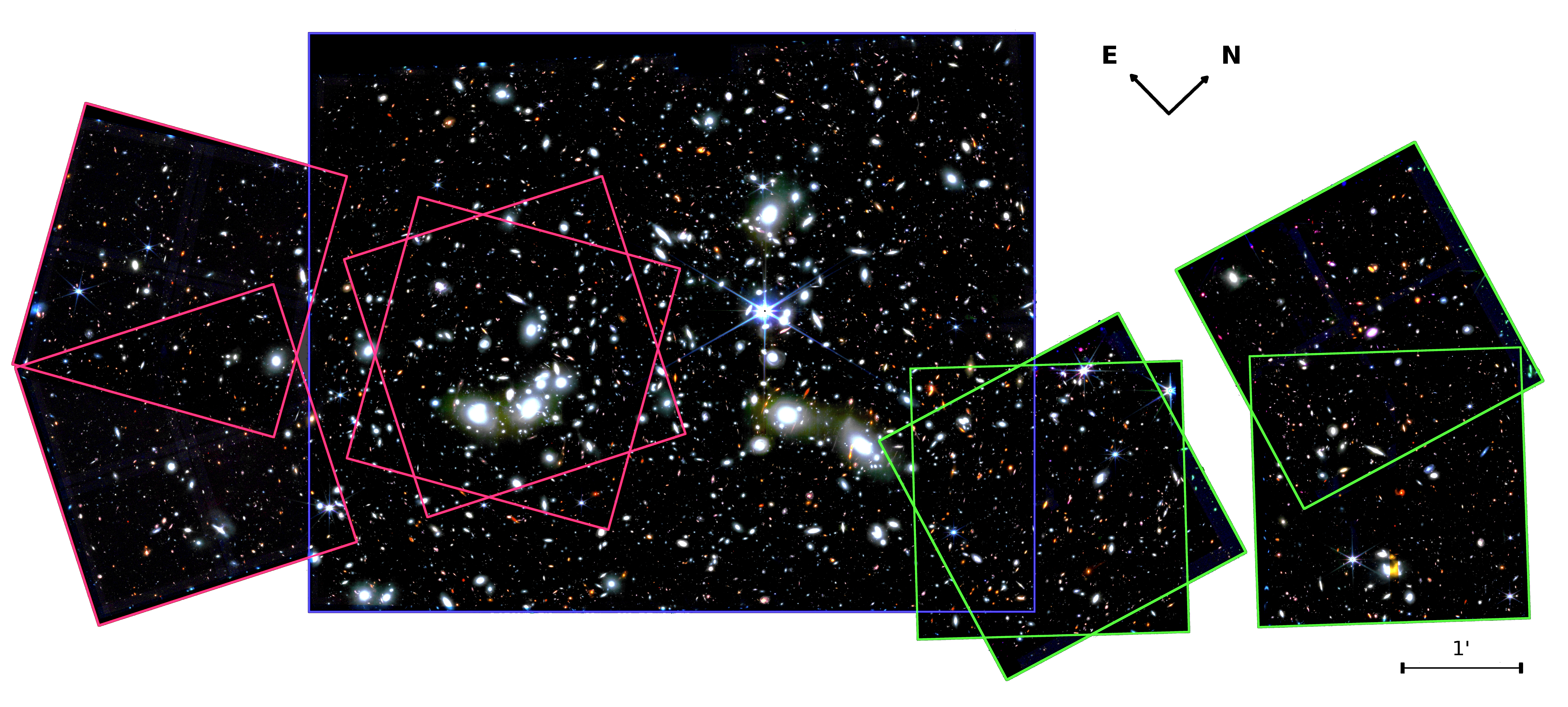Mission Overview
The GLASS JWST Early Release Science Program
(GLASS-JWST)
Primary Investigator: Tommaso Treu
HLSP Authors: GLASS-JWST Team
Released: 2023-07-07
Updated: 2024-10-25
Primary Reference(s): Treu, T. et al. 2022, Paris, D., et al. 2023, Mascia et al. 2024
DOI: 10.17909/kw3c-n857
Citations: See ADS metrics
Readme.md (see also: author README)
Source Data:

Overview
The GLASS-JWST Early Release Science Program (hereafter GLASS-JWST ERS) has obtained the deepest observations of galaxies obtained of all Early Release Science Programs by targeting the Hubble Frontier Field, and in particular the lensing cluster Abell 2744. This high-level science product collection combines the GLASS-JWST NIRCam imaging data (ERS-1324) with NIRCam data from two other JWST programs targeting the same field: UNCOVER (GO-2561; PI: I. Labbé and R. Bezanson) and Program DD-2756 (PI: W. Chen). The observed area in the wide-band filters - covering the central and extended regions of the cluster, as well as new parallel fields - is 46.5 arcmin2 in total.
The spectra are from NIRSpec observations in the Abell 2744 field, and were obtained in this program, and from the program DDT-2758 (PI: Chen). Please refer to Mascia et al. (2024) for more details on the GLASS-JWST Spectroscopic Data.
Data Products
The first release of this collection includes JWST NIRCam mosaics plus root-mean-square (RMS) maps for 8 IR filters. The mosaics were produced by the JWST calibration pipeline, as supplemented by several custom procedures developed by the GLASS-JWST team to correct for residual defects that were not addressed in standard processing. All mosaics are in FITS format with brightness in μJy/sr and a zero-point of ZP_AB = 23.9.
The first release also includes a mult-wavelength catalog consisting of photometry from these mosaics, and is combined with publicly available HST photometry in the F435W, F606W, F775W and F814W ACS bands, and in the F105W, F125W, F140W and F160W WFC3 bands. The photometric catalog was derived by detecting objects in the NIRCam F444W image and computing PSF-matched forced photometry on the remaining bands, using various apertures. The apertures sizes were 0.28′′, 0.56′′, 1.12′′ and 2.24′′ (corresponding to 2×, 3×, 8× and 16× the point-spread function (PSF) of the F444W image, respectively), and also the isophotal (segmentation) aperture. The resulting catalog contains 24,389 sources.
The second release consists of 263 spectral images and extracted spectra of 245 unique sources obtained with NIRSpec in the Abell 2744 field. The Level-1 products were produced by the JWST calibration pipeline, and the higher level products were produced with msaexp. The spectral coverage depends upon the redshift of the sources. The products also include a spectral template of high-redshift galaxies, which was constructed by stacking the 74 highest-quality spectra that span redshifts from 0.3 to 9.3.
The second release also includes a spectral line detection catalog, which indicates for each spectral source which of more than 60 emission lines were detected with a signal-to-noise ratio of at least 5.
Data file naming convention:
hlsp_glass-jwst_jwst_<instrument>_abell2744_<optElem>_v1_<prodType>.fits
where:
- <instrument> is either nircam or nirspec
- <optElem> is the optical element name:
- one of f090w, f115w, f150w, f200w, f277w, f356w, f410m, f444w for images
- one of f100lp-g140h, f170lp-g235h, f290lp-g395h, clear-prism for spectra
- <prodType> is the product semantic type, shown below:
| _sci |
Science image |
| _rms | RMS image |
| _spec | Source spectrum (incl. 2-D and 1-D extractions) |
| _spec-template | Stacked spectrum template |
| _cat | Catalog |
Data Access
GLASS-JWST images and spectra are available in the MAST Portal (the web-based, cross-mission search interface) and Astroquery (a Python package to search for and download files from Python scripts you write), and via the direct download table below. Set the Provenance Name filter to GLASS-JWST in the Portal Advanced Search to find the data products.
from astroquery.mast import Observations
all_obs = Observations.query_criteria(provenance_name="glass-jwst")
data_products = Observations.get_product_list(all_obs)
Observations.download_products(data_products)
-
A web-based interface for cross-mission searches of data at MAST or the Virtual Observatory
-
Search for and retrieve GLASS-JWST data products programmatically.
Direct Download
Access the JWST special products from the table below. The catalog sizes are small, but the spectral template is approximately 2.4 MB.
| Content Type | File Link | |||||||
|---|---|---|---|---|---|---|---|---|
| Photometric catalog |
hlsp_glass-jwst_jwst-hst_multi_abell2744_multiband_v1.0_cat.fits.gz |
|||||||
| Composite spectral template | hlsp_glass-jwst_jwst_nirspec_abell2744_v1_spec-template.fits | |||||||
| Emission line detection catalog | hlsp_glass-jwst_jwst_nirspec_abell2744_v1_cat.fits | |||||||
The photometric source catalog consists of a FITS file with multiple BINTABLE extensions, named corresponding to the photometric aperture on which the photometry was performed. The emission line detection catalog consists of a FITS file with two BINTABLE extensions.


